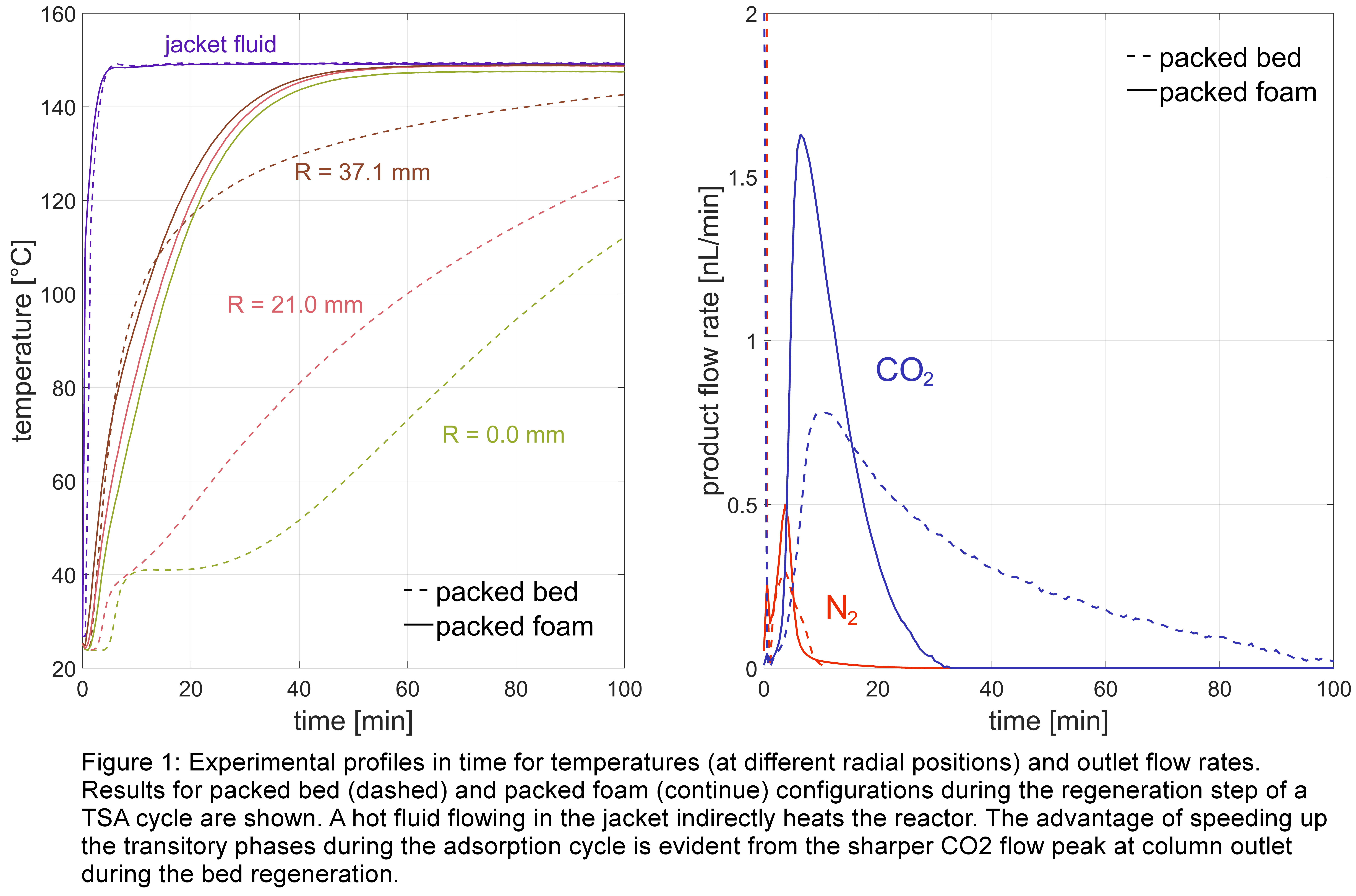(611f) Heat Intensification of TSA Processes with Packed Metal Foams: An Experimental and Modeling Study Applied to Post-Combustion CO2 Capture
AIChE Annual Meeting
2020
2020 Virtual AIChE Annual Meeting
Separations Division
Structured Adsorbents: Beyond Pellets and Beads
Thursday, November 19, 2020 - 9:15am to 9:30am
In the proposed configuration, the metal foam is placed in the reactor first. The void cells of the foam are then filled with the sorbent pellets. Keeping the average diameter of the particles less than half of the average diameters of the foam cells, filling can be simply performed by gravity. According to experimental measurements, this configuration also allows to house solid inventories (per unit reactor volume) much larger than those obtained with typical washcoated structured supports, and almost comparable to the ones of packed bed reactors. With this contribution, we propose the – to the best of our knowledge – first application of the packed metal foams as an alternative to the standard fixed bed configuration in adsorption based separations.
In particular, in this study, a post-combustion CO2 capture process application has been investigated. In the context of CO2 capture from flue gas, TSA processes are a promising alternative to the more established amine-wash[2]. Differently from absorption-based separations, a TSA cycle is not operated as a steady state process, but rather as a sequence of steps undergone by the gas-solid contactors. The simplest possible cycle configuration consists of: 1. an adsorption step during which the flue gas is fed, performed at low temperature to maximize CO2 intake; 2. a desorption step, i.e. a heating ramp with the consequent release of the adsorbate, where the high-purity CO2 stream is produced; 3 a final cooling step, which brings the system back to its initial state. The cooling step is performed in static conditions (i.e., both column ends are closed), whereas the other steps are typically performed at low velocities, well under the fluidization threshold, to contain the pressure decay.
In order to observe temperature gradients in both the axial and the radial direction within the reactor, a jacketed large cross-section (80 mm diameter and 200 mm length) cylindrical adsorption column has been adopted as experimental setup. It has been filled packing spherical zeolite 13X pellets (average diameter 1.8 mm) into an aluminum foam with a void fraction of 0.95 and a cell size of 5 mm. For this arrangement a total sorbent volumetric fraction of 0.50 has been measured, which represents a 25% reduction of the solid inventory compared to a standard packed column (at fixed reactor volume). A first series of steady-state and dynamic heat transfer tests has been completed by flowing inert gas (Argon) at different velocities through the column, and analyzing axial and radial temperature profiles across the packed foam. A detailed mathematical model for the description of the system dynamics in two spatial dimensions (axial and radial) has been validated by means of the experimental results.
Moreover, a second series of experiments has reproduced the operation of a basic TSA cycle (adsorption, heated regeneration, closed cooling) for the separation of a cry binary 12/88%v. CO2/N2 mixture. The cycle have been performed both in a packed bed and in a packed foam configuration. Pressure and temperature profiles within the column, as well as the composition of the outlet gas flow, have been monitored. The aforementioned reactor model has been extended to account for adsorption, also in view of its implementation into a process simulation tool, which could enable a systematic optimization of the process design. The final model has also been validated by means of the experimental results, for both packed bed and packed foam configurations.
Thus, in conclusion, experimental and modeling results demonstrate that heat transfer rates are increased by up to a factor two, as conjectured at the beginning of the study. This translates into a flatter temperature distribution along the reactor radius, and a faster transition toward the steady state when switching between heated and cooled steps.
As regards the specific application for CO2capture from flue gas, simulations have allowed, on the one hand, to quantify the productivity benefits obtained by cutting off the duration of the regeneration and cooling steps by a factor of three, and, on the other hand, to assess the disadvantages related to the lower packing densities, which limit the total adsorption capacity per unit volume.
References
[1] Visconti C.G., Groppi G. and Tronconi E., Catal. Today., 2016, 273,178-186
[2] Joss L., Gazzani M., and Mazzotti M., Chem. Eng. Sci., 2017, 158, 381-394
Acknowledgements
The authors thank Casale SA for the financial and technical support granted to the project.
